Cheri Samba: The Game-Changer of African Art
Who is Cheri Samba and what is his contribution to African Art?
Chéri Samba is an acclaimed contemporary painter from the Democratic Republic of Congo, whose work has significantly contributed to the global recognition of African Art. Born in 1956, he started his career as a sign painter, drawing on cardboard and highlighting social issues around him. This informal training laid the groundwork for his distinctive style that combines text and image, often using himself as the protagonist.
Samba’s contribution to African art lies in his innovative style, his incorporation of text, and his ability to tackle complex social themes. His work helped to establish the genre of “popular painting,” an art form that conveys complex socio-political commentary through accessible and relatable imagery. This has influenced a generation of African artists who use their art as a platform for social commentary.
In the global art scene, Samba has been a strong advocate for African artists. He was one of the first contemporary African artists to achieve recognition on the international stage, helping to pave the way for future generations. His work has been featured in major international exhibitions, including the 2007 Venice Biennale, asserting African Art’s place in the global contemporary art scene.
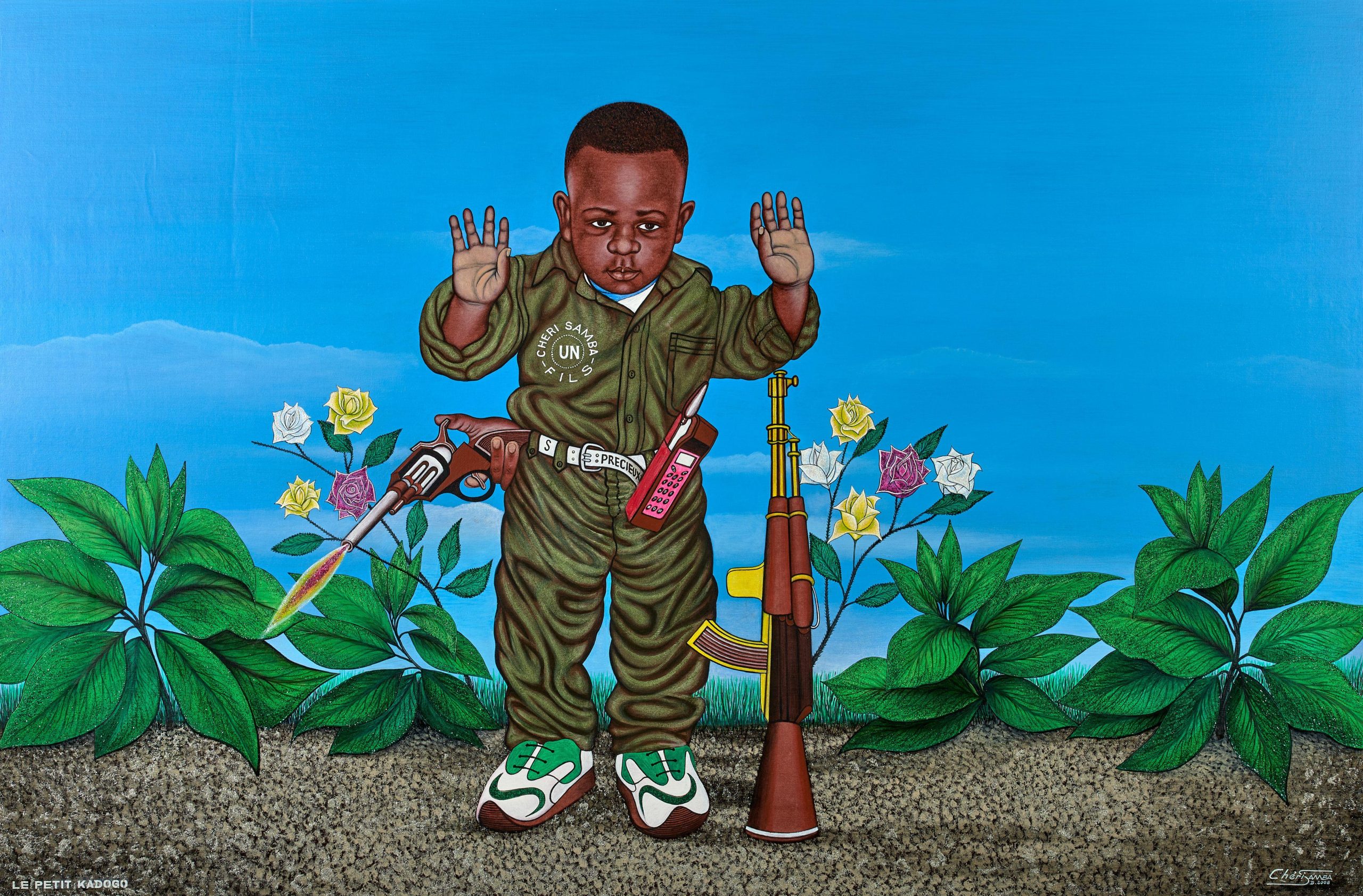
What are the distinctive characteristics of Cheri Samba’s art?
Cheri Samba’s art, a synthesis of painting and writing, is notably distinguishable through its vibrant palette and graphic style that bring forward a unique visual language.
Samba’s early years as a billboard painter and comic strip designer have distinctly influenced his art. He often uses bold outlines and flat areas of color, a style reminiscent of comic book aesthetics. This attention-grabbing style has become a signature, making his work immediately recognizable.
One of the unique features of Samba’s work is his integration of text into his paintings. These texts, often in French or Lingala, provide commentary or explanation, giving the viewer insights into the complex themes he tackles. The use of text creates a dialogue with the viewer, challenging them to engage with the artwork on a deeper level.
Self-representation is another distinctive characteristic of Samba’s work. He often appears in his paintings, portraying himself in various roles – an observer, a critic, or a participant. This strategy is not merely autobiographical, but also a form of engaging in self-critique and commentary on the artist’s role in society.
The use of unconventional materials is another distinctive feature of Samba’s work. His paintings are often created on sacking cloth (a type of coarse hessian fabric), a departure from the traditional canvas. This choice of material is significant, not just for its texture and visual impact, but also for its socio-economic connotations.
The boldness and audacity of Samba’s style coupled with his social commentary set him apart in the contemporary African art scene. By using a distinct visual language, he manages to address serious topics while maintaining a sense of humor and accessibility.
For more detailed insights into Cheri Samba’s distinctive artistic style, consider visiting this page.
How has Cheri Samba’s work evolved over time?
From his early days as a sign painter in Kinshasa to his recognition on the international art scene, Cheri Samba’s work has seen significant evolution while remaining true to his unique style and thematic focus.
Samba began his artistic journey creating signs and billboards, where the main objective was to attract attention. This formative period left a lasting impact on his work, as seen in his vibrant color palette, bold outlines, and graphic style. Over time, these elements became more refined and nuanced, serving as a powerful visual language for his socio-political commentary.
In the 1980s, Samba began to incorporate text into his paintings. Initially used sparingly, the text soon became a critical component of his work. As he grew more comfortable with this format, his texts became longer, transforming his paintings into narrative scenes that share a story or offer a critique.
Self-portraiture is another element that evolved in Samba’s work. While he had always included himself in his paintings, his representations became more symbolic over time. Samba started to use his image to critique the role of the artist, exploring themes of celebrity, authority, and responsibility.
Despite these changes, Samba’s work has always remained focused on social themes. Whether it’s addressing societal issues in the Democratic Republic of Congo or tackling global problems, his commitment to using art as a platform for social commentary has remained consistent.
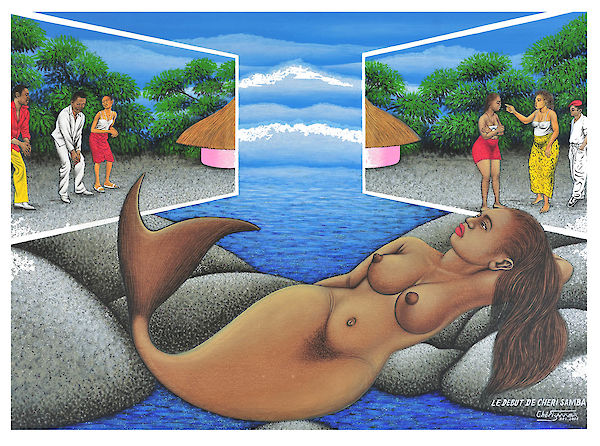
What themes and subject matters does Cheri Samba explore in his work?
Cheri Samba’s work is admired for its distinctive visual style and its ability to illuminate various themes related to both personal and collective experiences.
His paintings provide a critical examination of socio-political situations. He critiques societal issues such as corruption, poverty, and inequality, often highlighting their impacts on the lives of ordinary people in the Democratic Republic of Congo. His 1997 painting “J’aime la Couleur,” for example, is a commentary on the struggle for political power and its ramifications.
Samba also explores the themes of sexuality and gender relations. His paintings often challenge conventional norms and power structures, making bold statements about gender inequality and the dangers of ignorance about sexual health.
The role of the artist in society is another recurring theme in Samba’s work. He often presents himself in his paintings, exploring questions of celebrity, responsibility, and the power of art. His work serves as a critique of the art world, questioning its practices and assumptions.
Globalization and its impacts are also important themes in Samba’s work. He examines how globalization affects culture, identity, and socio-economic conditions, often highlighting its contradictions and disparities.
Lastly, Samba’s work also addresses the theme of spirituality, showing its influence on personal and societal life. His painting “The True Map of the World” is a powerful representation of his spiritual beliefs and their influence on his worldview.
For more details about the themes and subject matters in Cheri Samba’s work, you can refer to this page.
How has Cheri Samba influenced other African artists?
Cheri Samba, through his distinctive style and approach, has profoundly influenced a generation of African artists.
Samba’s decision to integrate text and narrative elements into his paintings was innovative and has inspired many artists to experiment with similar techniques. This fusion of visual and verbal expression is now a significant feature of contemporary African art.
His approach to social commentary has also been influential. Samba uses art as a platform to tackle societal issues, providing a blueprint for artists seeking to engage with their societies in a meaningful way. His boldness in addressing sensitive issues has paved the way for others to do the same.
Furthermore, Samba’s success on the international stage has provided a model for other African artists. He has shown that it’s possible to achieve international recognition without compromising one’s artistic identity or cultural roots. His career has demonstrated the potential for African art to contribute to global contemporary art discourse.
Finally, Samba’s use of unconventional materials, such as sacking cloth, has also been influential. This has encouraged other artists to explore a wider range of materials, thereby expanding the possibilities of what can be considered ‘art’.
To learn more about Cheri Samba’s influence on other African artists, check out this page.
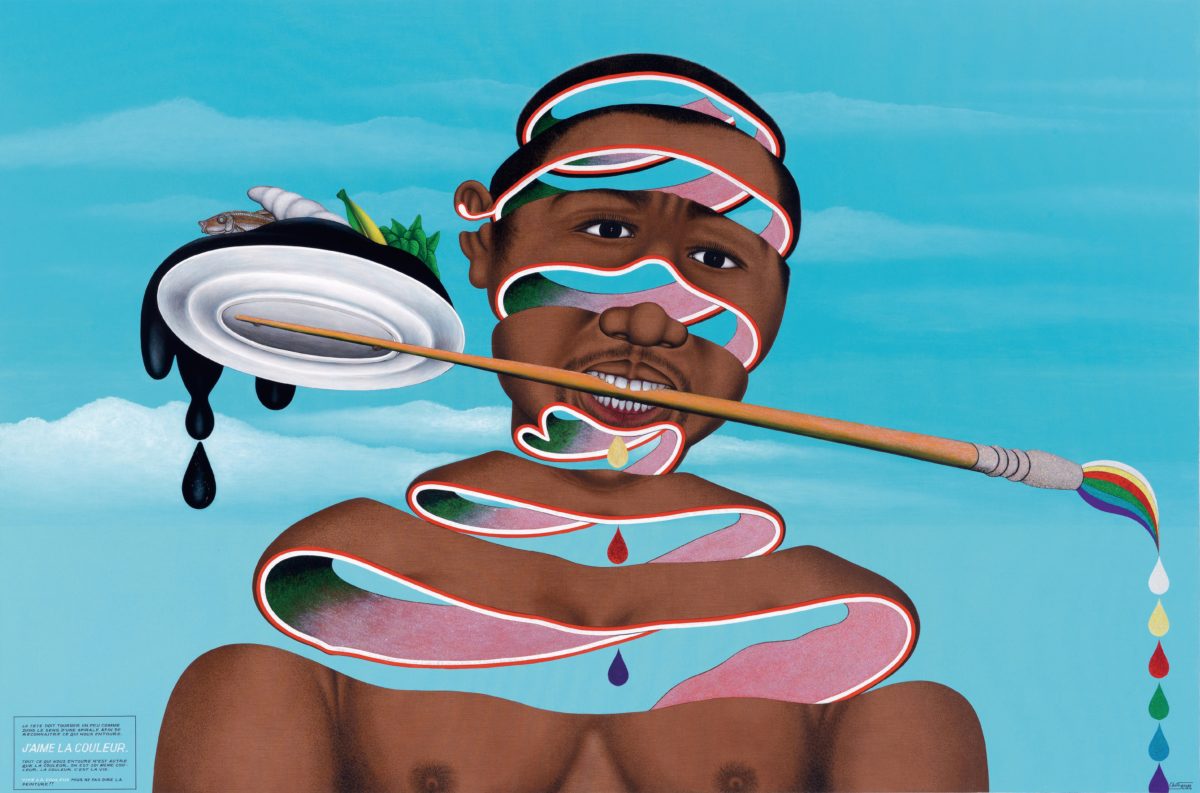
What is the global impact and reception of Cheri Samba’s work?
Cheri Samba has achieved significant recognition and respect in the international art community, impacting not only the perception of African Art but also contributing to global contemporary art discourse.
His debut in the international art scene was marked by his participation in the 1989 “Magiciens de la Terre” exhibition at the Centre Georges Pompidou in Paris, where his work was showcased alongside renowned international artists. This was a turning point, not just for Samba, but for many African artists who had been largely absent from the international contemporary art scene.
Samba’s work is now part of prestigious collections worldwide, including the Museum of Modern Art in New York and the Centre Georges Pompidou in Paris. His paintings have been showcased in various international exhibitions and biennales, further establishing his global presence.
Critics and scholars have praised Samba’s innovative style, especially his integration of text and image, and his ability to critique social issues through accessible and relatable imagery. His unique visual language and poignant socio-political commentary have contributed to a broader understanding of the possibilities of contemporary art.
Samba’s global impact extends beyond the art world. His paintings, with their vivid depiction of African life and societal issues, have fostered international conversations about culture, globalization, and social justice.
To learn more about the global impact and reception of Cheri Samba’s work, you can explore this page.
Can you share some of Cheri Samba’s most iconic works and the stories behind them?
Cheri Samba’s body of work is vast and varied, with many iconic pieces that have become synonymous with his name. Here, we explore a few of his most celebrated works.
“J’aime la Couleur” (1997) is one of Samba’s most recognized paintings. The artwork depicts a political rally, with Samba at the center, holding a palette. The vibrant colors and the crowd’s fervor serve as a commentary on the political landscape and the power dynamics inherent in it.
“The True Map of the World” (2003) is another iconic piece. It presents a globe filled with texts and images, depicting Samba’s interpretation of world events and his spiritual beliefs. The painting reflects Samba’s critique of globalization and his vision of an interconnected world.
“Life Circle” (2014) is a work that stands out for its autobiographical elements. Samba depicts himself in the center of a circle of life events and personal experiences, revealing the artist’s reflections on his journey and identity.
“Le Prophète et la Prophétie” (2008) is a poignant depiction of the power of prophecy and belief in shaping reality. It showcases Samba’s ability to blend spiritual themes with social commentary.
Each of these works is unique and insightful, offering a glimpse into Samba’s creative mind and his skill in bringing complex concepts to life.
To delve deeper into Cheri Samba’s most iconic works and the stories behind them, visit this page.
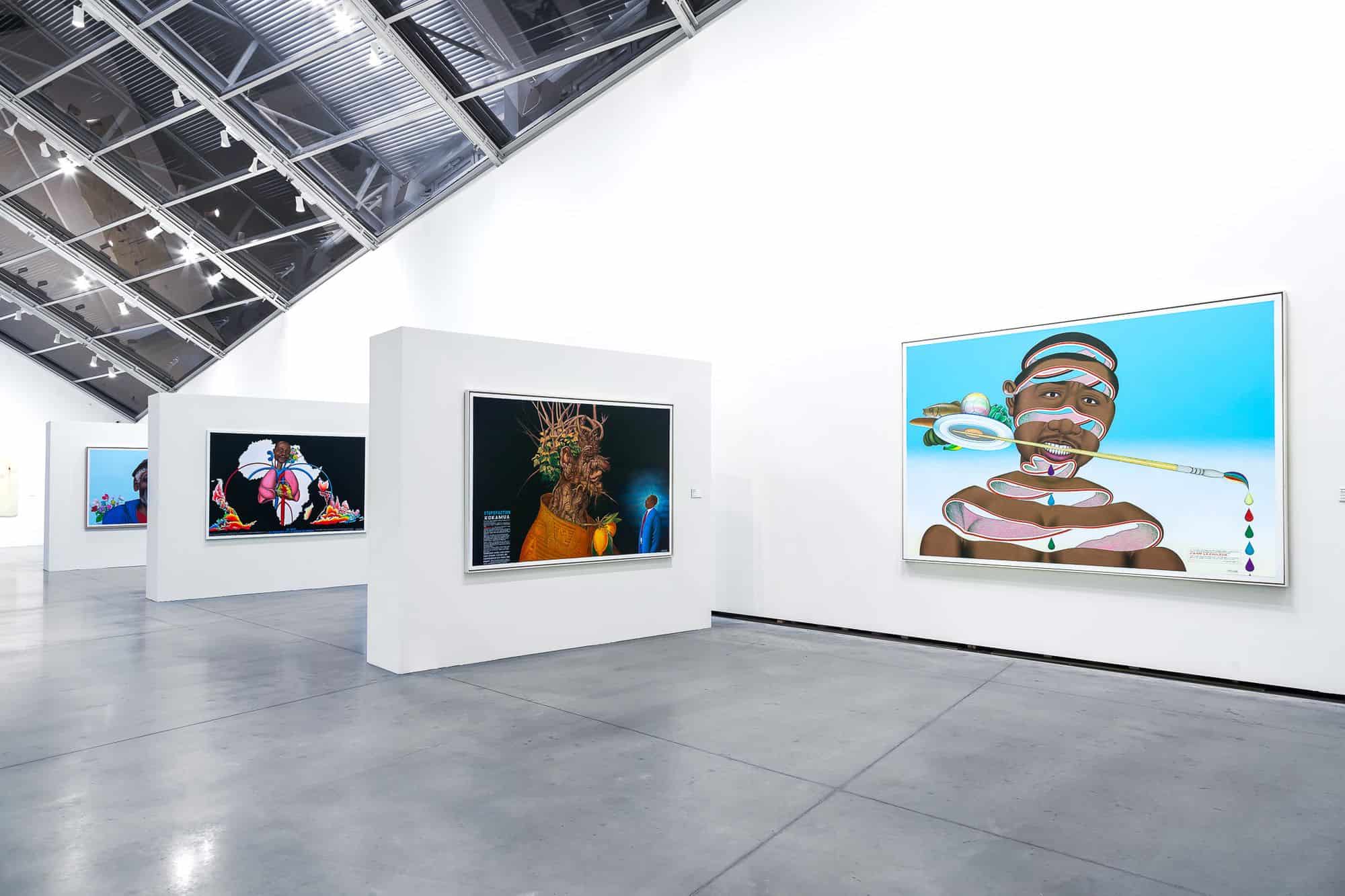
What role has Cheri Samba played in documenting culture and preserving heritage through his art?
Cheri Samba’s art is a vibrant testament to his Congolese culture, capturing the essence of daily life, societal issues, and local traditions. His work, while contemporary in style, serves as a living document of his community’s culture and heritage.
Samba’s paintings often depict scenes from everyday life in Kinshasa, capturing the city’s energy, dynamics, and complexities. His paintings also reflect traditional Congolese values and practices, often with a modern twist.
Samba’s use of Lingala and French in his artworks further contributes to his role as a cultural documentarian. His integration of text in local language allows for preservation and promotion of his linguistic heritage.
His work also preserves and showcases traditional African art forms and aesthetics, albeit in a modern context. His use of bright colors, bold patterns, and flat pictorial space often echoes traditional African visual culture.
His paintings, particularly those depicting societal issues, serve as historical documents, capturing specific periods of Congolese history. His art presents an alternative historical narrative, one that is rooted in personal and communal experiences.
Cheri Samba’s work not only documents culture and heritage but also stimulates dialogue and promotes understanding. For a deeper dive into Samba’s role in documenting culture and preserving heritage through his art, refer to this page.
How does Cheri Samba incorporate social commentary in his art?
Cheri Samba’s art is a compelling blend of visual creativity and social commentary. His work uses humor, satire, and narrative elements to critique and reflect on a variety of societal issues.
Social commentary in Samba’s work often revolves around societal issues in his home country, the Democratic Republic of Congo. He critiques political corruption, social inequality, and the complexities of urban life in Kinshasa.
Samba’s use of text adds an extra dimension to his social commentary. His paintings often feature written commentary or dialogue, providing a more in-depth exploration of the issues presented in the visuals. The texts, often written in French or Lingala, provide context, share personal thoughts, or challenge the viewer to think critically about the depicted issues.
Samba also frequently includes himself in his paintings, either as an observer or participant. This self-representation allows him to weave personal experiences into broader social commentary, adding a layer of authenticity and immediacy to his critique.
Notably, despite dealing with serious issues, Samba’s work often maintains a sense of humor and optimism. This approach makes his social commentary accessible, engaging, and relatable to a wide audience.
To further understand how Cheri Samba incorporates social commentary in his art, you can explore this page.

What is the connection between Cheri Samba’s art and spirituality?
Spirituality plays a significant role in Cheri Samba’s work, influencing both his artistic expression and the themes he explores.
Samba, born and raised in the Democratic Republic of Congo, was deeply influenced by traditional Congolese spiritual beliefs. These beliefs often revolve around ancestral spirits, nature spirits, and the interconnectedness of the physical and spiritual worlds.
In his work, Samba often addresses spiritual themes either directly or indirectly. His painting “The True Map of the World,” for example, represents his spiritual perspective on the world. The artwork is filled with symbols and imagery that convey a sense of unity, interconnectedness, and a shared human journey.
Samba also addresses the topic of prophecy in his work. In “Le Prophète et la Prophétie,” he depicts a prophet-like figure, highlighting the role of prophecy and spiritual leaders in shaping societal beliefs and actions.
Samba’s spirituality also influences his approach to art-making. He sees art as a form of communication, not just with the audience but also with the spiritual world. Through his art, he attempts to make sense of the complexities of life and explore existential questions.
The connection between art and spirituality in Samba’s work provides a unique lens through which to understand his creative process and thematic explorations. To learn more about the spiritual dimensions of Cheri Samba’s art, you can visit this page.
What are the techniques used by Cheri Samba in his artwork?
Cheri Samba’s artwork is distinguished by its unique combination of visual, textual, and narrative elements. His art is characterized by a vivid color palette, bold graphic style, and the integration of written texts.
Samba employs a flat, two-dimensional style in his paintings, drawing inspiration from his early career as a sign painter and comic strip designer. Bold outlines and vibrant colors are the defining features of his art, resulting in a distinctive aesthetic that is both appealing and attention-grabbing.
One of the unique techniques used by Samba is the integration of text into his paintings. The texts, often in French or Lingala, serve to provide context, narration, or commentary, adding depth to the visual elements and inviting viewer engagement.
Samba’s self-representation in his paintings is another technique that distinguishes his work. By placing himself in various roles within his art, Samba encourages introspection and dialogue about the artist’s role in society.
Moreover, Samba often uses unconventional materials for his paintings, such as sacking cloth, providing a unique texture and adding socio-economic connotations to his work.
These techniques combined give Samba’s work its distinctive style and narrative depth. To explore more about the techniques used by Cheri Samba in his artwork, visit this page.
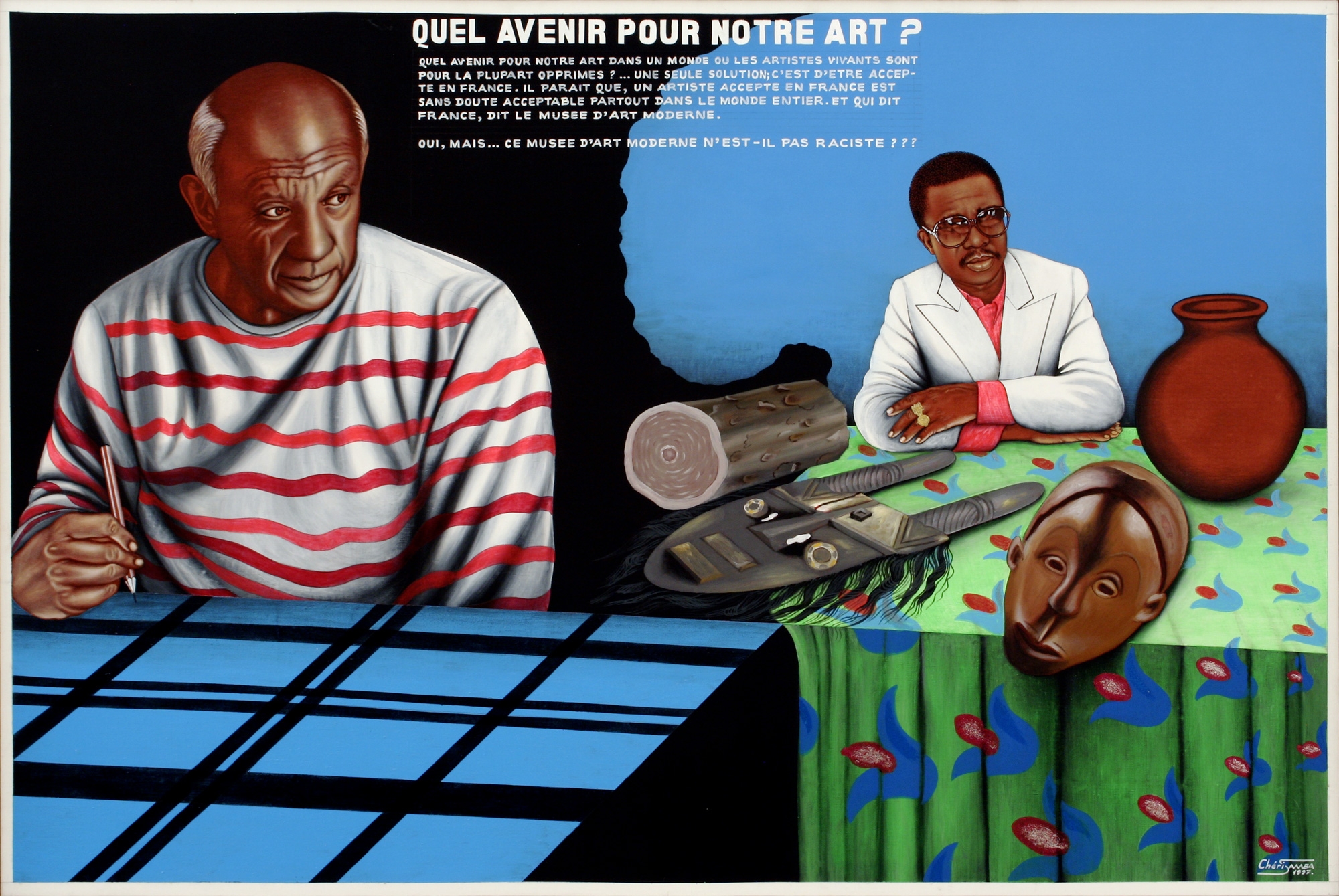
| Article Topic | Key Insights |
|---|---|
| Who is Cheri Samba and what is his contribution to African Art? | Cheri Samba is a renowned contemporary painter from the Democratic Republic of Congo who has significantly contributed to African Art through his innovative style and social commentary. |
| What are the distinctive characteristics of Cheri Samba's art? | Samba's art is known for its vibrant color palette, bold graphic style, integration of text and image, and self-representation. |
| How has Cheri Samba's work evolved over time? | From sign painting to the international stage, Samba's work has evolved in style and substance, always remaining focused on social commentary. |
| What themes and subject matters does Cheri Samba explore in his work? | Samba's work explores socio-political situations, gender relations, the role of the artist, globalization, and spirituality. |
| How has Cheri Samba influenced other African artists? | Samba has influenced African art through his innovative style, approach to social commentary, international success, and use of unconventional materials. |
| What is the global impact and reception of Cheri Samba's work? | Samba has achieved international recognition, significantly impacting global contemporary art discourse and fostering conversations about culture, globalization, and social justice. |
| Can you share some of Cheri Samba's most iconic works and the stories behind them? | Some of Samba's most iconic works include "J’aime la Couleur," "The True Map of the World," "Life Circle," and "Le Prophète et la Prophétie." |
| What role has Cheri Samba played in documenting culture and preserving heritage through his art? | Samba's work serves as a living document of his community's culture and heritage, preserving and showcasing traditional African art forms and aesthetics. |
| How does Cheri Samba incorporate social commentary in his art? | Samba's work uses humor, satire, and narrative elements to critique and reflect on societal issues. |
| What is the connection between Cheri Samba's art and spirituality? | Samba's work is deeply influenced by traditional Congolese spiritual beliefs, and he often addresses spiritual themes in his art. |
| What are the techniques used by Cheri Samba in his artwork? | Samba's work is characterized by a vivid color palette, bold graphic style, the integration of text and image, self-representation, and use of unconventional materials. |



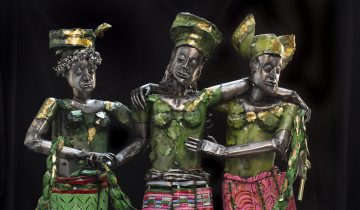
 No products in the basket.
No products in the basket.